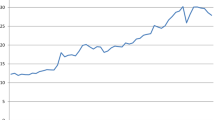Abstract
Institutional regionalization has come very late to East Asia compared with Europe, but its pace has dramatically increased since the mid-1990s. Many agreements, including bilateral ones such as those signed between Japan and Singapore, or pluri-lateral ones such as those between ASEAN countries, cover an ever increasing number of countries of the East Asian region, including Japan, India, and China. We first analyze Asian integration as a de facto, spontaneous, development of trade. Trade specialization in Asia has often been described as guided by the different levels of development of the countries participating in the regional integration. It constitutes a vertical division of labor between poor countries exporting natural resources and/or labor-intensive products to developed countries exporting machinery, sophisticated parts and components, and high-tech products. This trade structure is radically different from the European horizontal division of labor (exchange of different varieties of similar goods). Then we look at the micro-economic level how Japanese firms tend to integrate Asia into their international network, with Japanese partners being used as relays for Japanese export of semi-manufactured products. Last we present a simulation with the MIRAGE model of a scenario of general regionalization in which all the regions of the world develop preferential treatment for neighboring countries. These agreements are limited to industrial products with particular attention to the automotive sector. The main results are that Asia is the main winner in such a scenario, and within Asia it is Japan and Korea that will be the main winners. In fact, because developing Asia is one of the most protected regions of the world, the impact of liberalization is also the highest. Second, Japan and Korea are best placed to profit from these regional agreements, because other developed countries are excluded from the market of developing Asia. They also have superiority in manufacturing goods whereas countries like China might have problems upscaling their industrial production. Nevertheless our model did not take into account the voluntary pace of development chosen by China and that she will use her powerful state system to avoid being locked into low-tech, low-value-added products.












Similar content being viewed by others

Notes
This is one of the limits of this simulation exercise as we are not allowed to increase investment in a non-competitive industry. CGE models are, from that point of view, rather conservative.
References
Ando M, Kimura F (2003) The formation of international production and distribution networks in East Asia, NBER working paper no 10167
Arndt SW (2003) Production sharing and regional integration. Working Paper, 02-03 Claremont McKenna College
Arndt SW (2004) Global production networks and regional integration. In: Plummer M (ed) Empirical methods in international trade essays in honor of Mordechai Kreinin, or in Working Paper, no. 03-01 Claremont McKenna College
Balassa B (1961) The theory of economic integration. R.D. Irving, Illinois (Reprinted 1982)
Bouët A, Decreux Y, Fontagné L, Jean S, Laborde D (2004) A consistent ad-valorem equivalent measure of applied protection across the world: the MAcMap-HS6 database. CEPII’s Working Paper no. 2004-22
Deardorff AV (2001) Fragmentation across cones. In: Arndt S, Kierkowsky H (eds) Fragmentation: new production patterns in the world economy. Oxford University Press, Oxford
Fouquin M (2002) Trade in textiles and clothing: comparing multilateral and regional trade agreements, with Avisse R, Integration and trade review no. 17, vol 6. Buenos Aires, July–December 2002
Fouquin M (2007) Economic integration in East-Asia. La Lettre du CEPII, La Documentation Française, no. 265, March
Gaulier G, Lemoine F, Unal Kesenci D (2004) China’s specialization in East Asian production sharing. Chapter 5
Henriot A (2004) Les échanges intra-firme: une nouvelle forme d’insertion internationale pour l’Asie émergente. Paris, COE
Hertel T (ed) (1997) Global trade analysis: modeling and applications. Cambridge University Press, New York, USA
Ng F, Yeats A (2003) Major trade trends in East Asia. Bank Policy Working Paper, no. 3084
Schiff M, Alan W (1998) Dynamics and politics in regional integration arrangements: an introduction. The World Bank Economic Review, vol 12, no 2
Viner J (1950) The customs union issue. The Carnegie Endowment for International Peace, New York and London
Yamazawa I (1990) Economic development and international trade: the Japanese model. East West Center, Honolulu
Author information
Authors and Affiliations
Corresponding author
Additional information
East Asia includes Japan, Korea, China, Taiwan, Hong Kong, and Singapore; plus Southeast Asia including Indonesia, Thailand, Malaysia, Philippines, Vietnam, Laos, Cambodia, and Myanmar.
Rights and permissions
About this article
Cite this article
Fouquin, M. Regionalization in East Asia. Econ Change Restruct 41, 289–313 (2008). https://doi.org/10.1007/s10644-008-9063-3
Published:
Issue Date:
DOI: https://doi.org/10.1007/s10644-008-9063-3



